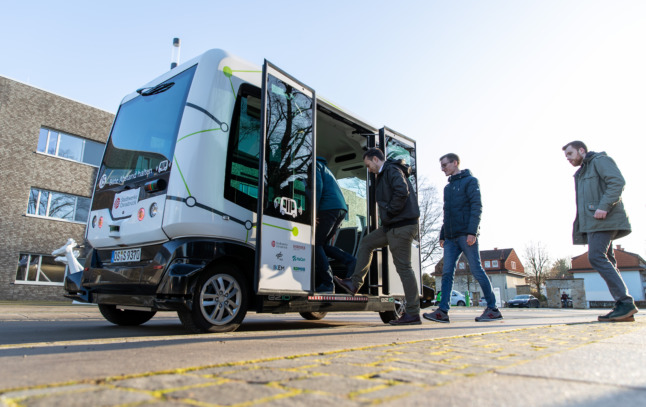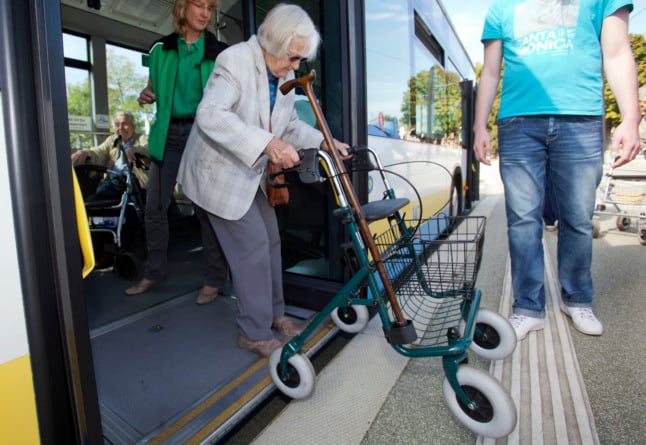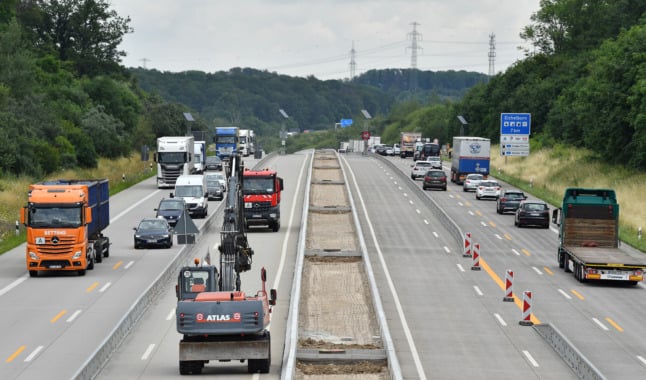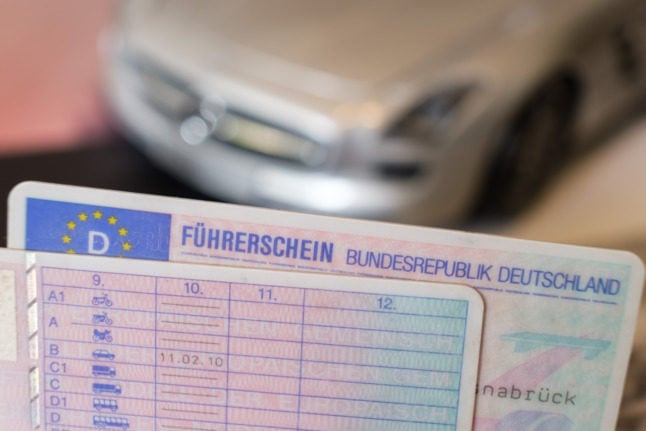The previously unpublished study, which was carried out by Berlin’s Social Science Research Centre (WZB) and the social research institute Infas, shows that people are continuing to choose car travel over trains and buses in spite of the easing of many Covid restrictions and a return to public life.
READ ALSO: Why (and where) Germans are choosing to go on holiday by car this year
In Spring 2021, almost half of all public transport users were instead travelling by car – compared to just a third at the height of lockdown.
The trend, in fact, is moving in the opposite direction of the climate targets for the transport sector, which dictate that the number of people using public transport needs to double over the coming years.
“As the backbone of the transport revolution, public transport is currently a total failure,” WZB’s transport researcher Andreas Knie told German daily Spiegel.
A lack of flexibility?
The fact that car use has increased in spite of the easing of lockdown restrictions suggests that factors other than the pandemic are at play in the migration to private rather than public modes of transport.
These include inflexible schedules and problems with routes that might make it less a less attractive option for people who drive.
According to the research, private vehicles remain the number one choice for around 60 percent of travel routes in Germany.
READ ALSO: Deutsche Bahn warns of worst-ever loss due to pandemic
“That many respondents are avoiding mass transit because of Covid-19 is only half the truth,” the researchers explained. “The other part of the story is that the lack of flexibility and low quality of the product are strong motives for avoiding public transport.”
Researchers believe that public transport providers are facing a “structural crisis” as they struggle to adapt to the changed realities of the post-pandemic working world.

Researches believe on-demand shuttle buses could be a public transport option that’s well suited to the post-pandemic world. Photo: picture alliance/dpa | Friso Gentsch
With more flexible working arrangements, employees who work from home may want services that allow them to nip into the office in the afternoon at short notice, or just for a few hours – but are frustrated by the limited options or lack of speedy connections.
Researchers suggest that services such as on-demand shuttle buses that could be ordered via app could be a solution to this. But outside of small pilot projects around the country, there’s been little movement in this direction so far.
Another issue facing transport providers is that products such as monthly and annual tickets are increasingly out of step with passengers’ daily lives and needs.
Instead, pay-as-you-go systems where the cheapest tariffs are automatically calculated on a chipcard or app could give people both the flexibility and value they want, the researchers explained.
Social division
The study’s data, based on representative surveys, interviews and tracking data from an app, also revealed a deep social divide across different modes of transport.
“Beyond the metropolises like Hamburg or Munich, higher earners hardly use public transport at all,” Knie told Spiegel.
With higher-income groups making up just two percent of kilometres travelled by public transport, options such as buses and trains are “practically non-existent” for the wealthy, he added.

The people still using public transport tend to be those who have no other choice, like elderly people who can no longer cycle. Photo: picture alliance / dpa | Jens Büttner
Public transport options, meanwhile, “are used by those who have no other choice,” the researcher concluded.
This group includes older people who no longer cycle and poorer people who aren’t able to travel the often long distance to work by car.
READ ALSO: ‘Infringement on air quality’: EU court slams Germany for pollution in cities
Conversely, researchers found that the number of kilometres travelled by car goes up in relation to income.
The upshot is that the transition to sustainable transport that’s long been hoped for by climate protectionists and urban developers could take much longer in Germany than previously thought.



 Please whitelist us to continue reading.
Please whitelist us to continue reading.
Surprise, surprise! Even in my “Green” State of Baden-Württemberg, the love for cars is just unbelievable. I don’t know why, but there just seems to be some kind of disconnect between car usage and other green policies. The same people you see purchasing/living carefully so as to avoid waste and reduce their climate footprints, then jump into their big Chelsea Tractors (SUV’s, if you are not familiar with the nickname) and race off, revving like crazy, ignoring the in-town speed limits (unless there are cameras, of course!), chugging up the fossil fuels and belching out the pollution. Children are dropped off at my local kindergarten by said “Jack Wolfskin’ers” in said “Tractors” leaving the engines idling and, not only creating more CO2, but also shrouding the kindergarten entrance in their diesel stink.
I was commuting to Frankfurt 3x each week and found very few issues with walking to, then from the railway station, followed by the 2-hour ICE ride. Yes, I could do it because I was working M/W/F and a 6-hour travel day was doable but I suspect that if a person was full-time, s/he would probably live closer to the place of work.
In my view (and I agree with the Berlin researchers), it’s not that the public transport service is poor, it’s just down to a personal choice; so mostly empty buses and trains ply the local routes. I had to laugh when I saw the article that said 80% of Germans are regular cyclists, well in my area, every Sunday is regular!
As I said, I just can’t understand it – I am at a loss and hope someone is able to enlighten me!!
Sitting in my local biergarten on Achern High Street: 10 buses passed in 1 hour, total people on board 22 including 10 drivers! Meanwhile, the same High Street was packed with cars, most of which contained only the driver.
I pay 85€ per month for a >20km area! If I travel outside of the city I live I have to then pay an additional 3,60€ per way (6,80€ per way if outside of my immediate “train association”). This is totally ridiculous to me! As a student its really not affordable, not to mention the horrendous service (ie trains often more than 10min late, non functioning bathrooms, ect). If I had the means, of course I would also directly buy a car! This article is really missing a huge point. If Germany really cared about reducing car usage, they would subsidise public transport costs by half, if not by even more! MINIMUM local transport within ones’ own city should be free… But I think this is another case where what German politicians say and what they end up promoting are opposite.
Yes, I agree – Germany has not, at least up to this point, seen any advantage in promoting public transport; after all, it has a World-beating auto industry. The only way to get people out of their cars and onto local transport is if it is reliable and affordable, both of which require the political will to make it happen! I hope the Greens get a BIG say in the next Federal government and do something about this.
They don’t even need to worry about offering new products like on-demand buses, just make sure the good old buses and trains are ON TIME and affordable. My recent decision to buy a whole new car and put an end to my 2-year commute by train has got nothing to do with the pandemic. The freedom of not having to plan my entire day around the eternally unreliable trains – not giving that up any time soon. The system is a joke for an advanced country like Germany.
I understand your pain! I think it depends on the route; I travelled for 3 years on the Baden-Baden to Frankfurt line with very few problems. The only major one was when some bright spark tunnelled under the line between Rastatt and Karlsruhe and caused the line to subside!
Well I just spent three weeks in Budapest – and the public transport there knocks spots off the one here in Hessen. Comparing Frankfurt and suburbs with Budapest is a no brainer. Busses, trams, tube and regional trains run much more frequently that in Frankfurt. In fact waiting in Frankfrut main station 28 minutes for as S-Bahn to Kronberg is unheard of in Budapest – especially in the main commute times.
The trains to Frankfurt run every 30 minutes and they never run more frequently. Shocking. And arriving at Kronberg (end of S4 from Frankfurt) station at 18:30 on a Saturday to find that the local buses have shut down for the weekend is just unbelieveable.
I pay 85€ per month for a >20km area! If I travel outside of the city I live I have to then pay an additional 3,60€ per way (6,80€ per way if outside of my immediate “train association”). This is totally ridiculous to me! As a student its really not affordable, not to mention the horrendous service (ie trains often more than 10min late, non functioning bathrooms, ect). If I had the means, of course I would also directly buy a car! This article is really missing a huge point. If Germany really cared about reducing car usage, they would subsidise public transport costs by half, if not by even more! MINIMUM local transport within ones’ own city should be free… But I think this is another case where what German politicians say and what they end up promoting are opposite.
Still better public transport than most of the UK…
One of the things Germany needs to rediscover is the ability to finish projects on time: there’s a massive programme of electrification here, where many lines are shut down for conversion to electric traction – yet they are routinely kept closed for way longer because of the delayed construction deadlines…